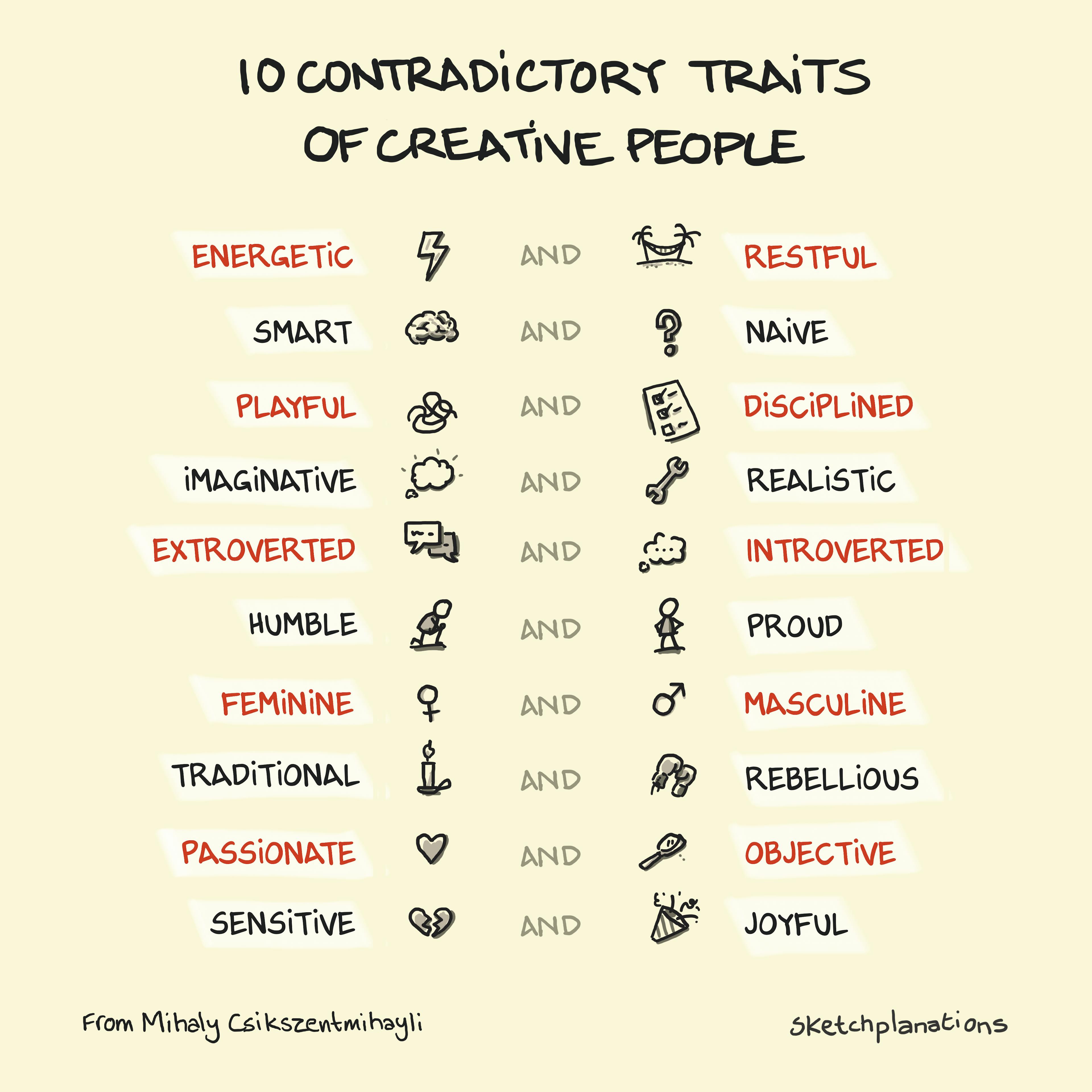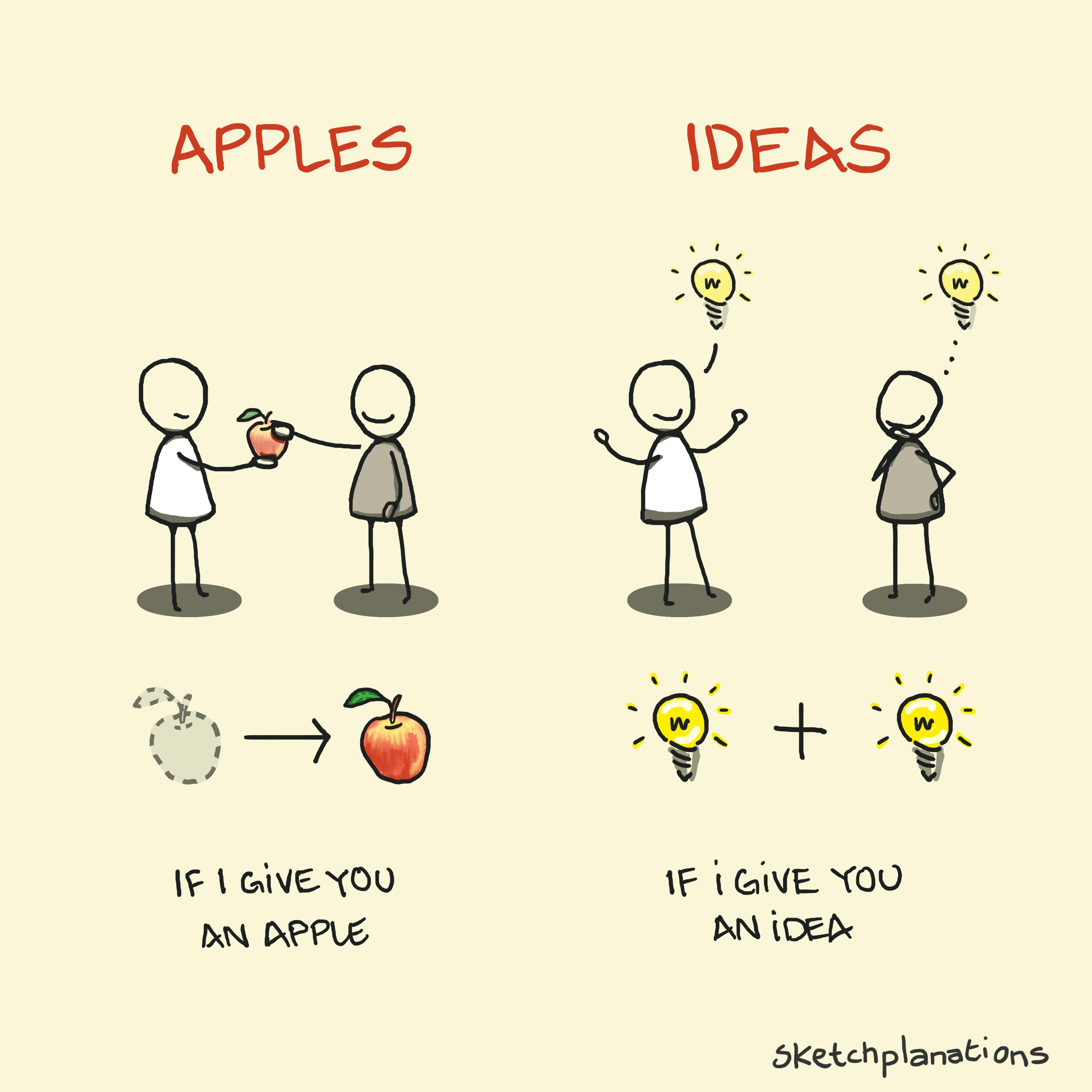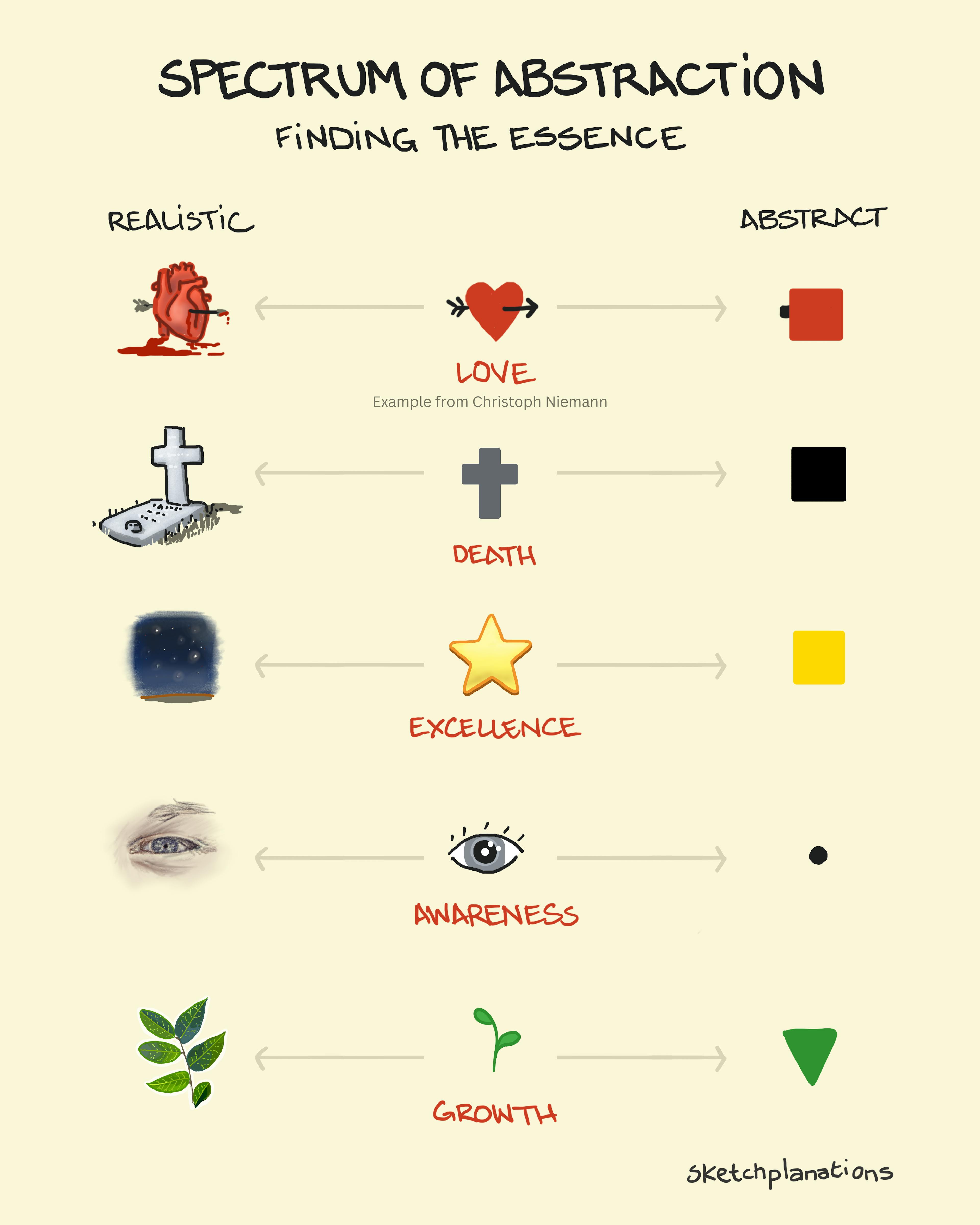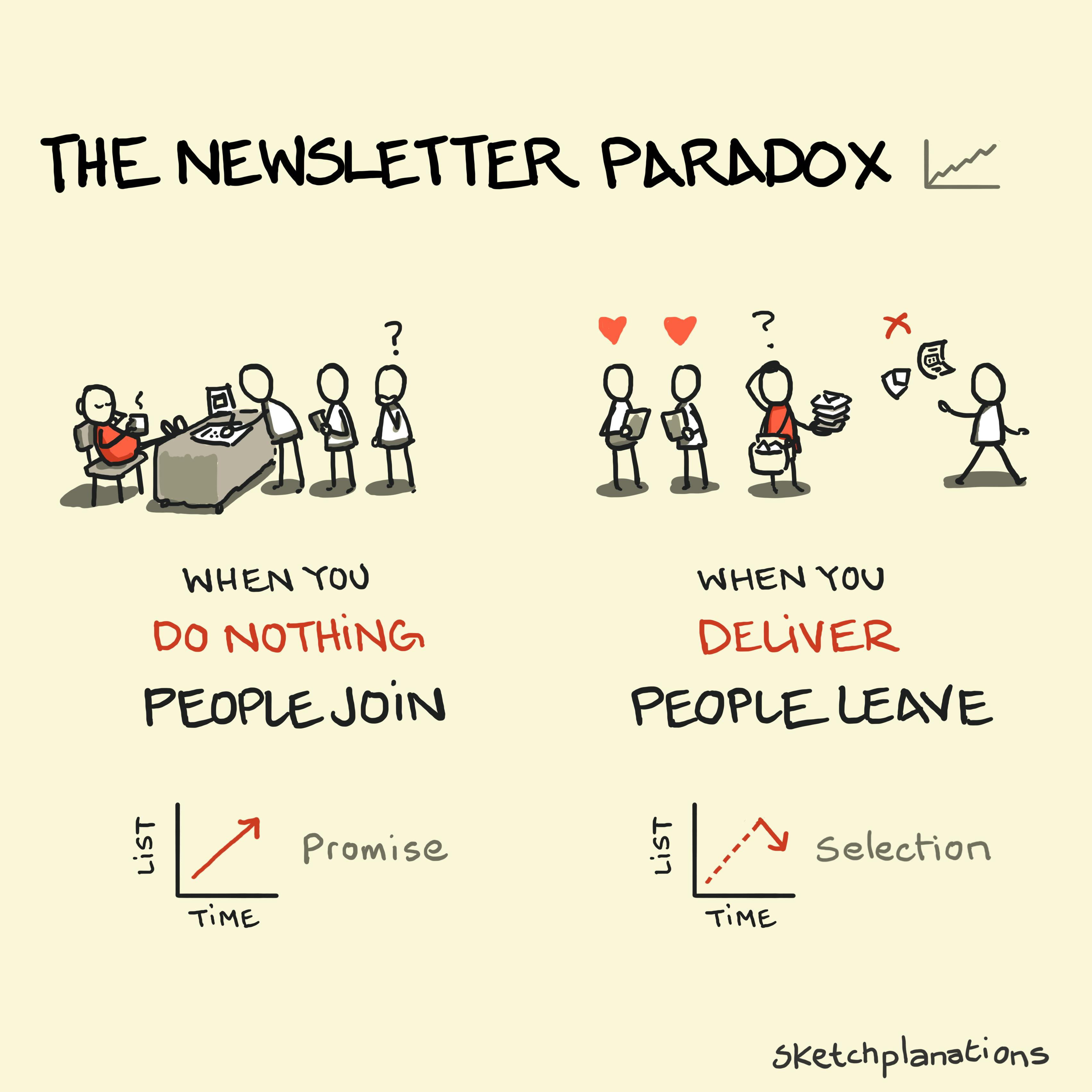Here's a curious and unsettling paradox that you might experience if you choose to write a newsletter: When you do nothing, people join, and your list grows. When you send an email to your list, your list shrinks and people leave. It can seem that people like it when you do nothing, and people don't like it when you publish. There's a fair chance this newsletter would reach more people if I hadn't published anything for a year. The Sawtooth Shape of Subscriber Growth The chart of my subscribers over time looks like a sawtooth. Every growth period is me doing nothing. Every dip—people unsubscribing—is me sending out my work 😅 It can seem like working hard and sending out your best work actually drives people away. A Familiar Pattern for Marketers If you're an email marketer, you're likely familiar with this phenomenon. Your website works hard to drive sign-ups. And when you send out mail, some people buy, but others unsubscribe. Every communication on a list or newsletter is a filtering moment—another chance for a reader to decide, "This is not for me," or "Yes, I still like this." It's also the only practical time to leave. I wonder at the sheer number of lists I must be on, but that aren't sending, and I actually can't unsubscribe because they haven't sent me anything with a link to do it. It's a little like my sampling bias sketch in reverse—if people can't easily unsubscribe without receiving a mail, you'll only see unsubscribes when you send. Much like when you ask people to enter an email address on a business site, a goal is to be clear enough about what people will get, so that when you deliver it matches expectations and people stay. Promise vs Selection Signing up is the Promise of receiving something interesting in the future. Every time you receive something, there's another Selection moment—Do I want this? Hope vs Reality. Each send is like a test to see if you and they are still a good fit. If you're writing a newsletter, the longer people stay, in principle, the better the fit. And, as in business, I learned not to take it personally. When people leave, it doesn't mean what you are doing is bad. It's not personal, it's just not for them. And other times, more prosaically, circumstances change, and what was a good fit just isn't needed anymore. So it’s not really a paradox, but it can certainly feel like one. Don't lose heart. A Note on Substack Sending emails feels very different from posting on social media (I also post new sketches on various social platforms). On social platforms, you literally can't ignore engagement metrics: likes, reposts, shares, comments—and most people don't want to (sort of). They can be either very motivating—"Wow, people loved that one!"—or demotivating—"I thought that one was great. Why did nobody like it??" Either way, you get a rough and skewed measure of interest in what you're doing. But don't take it as truth. For example, something I post that received no likes or interactions is then posted by someone else and takes off. Social media gives you a very distorted, if not downright misleading, view of what's valuable. Contrast that with sending an email newsletter. While a post on social might rack up likes and shares, with email, you often get nothing. I would send an email to 20,000 people and get tumbleweeds (apart from, inevitably, unsubscribes). Did people like it? Did people hate it? But from time to time, instead of likes or thumbs up, with email I receive wonderful, personal, thoughtful replies, notes and stories from individuals—something you will rarely, if ever, receive through social platforms. Substack (the platform I used to send this when I first published it) goes some way to bridging email and social. I can send an email like this one and receive personal replies straight to me. And I can also get a vague and imperfect idea of what people think about it through likes and comments. By the way, if you ever want to click the "like" button on an email, I appreciate it and it probably helps more people find this newsletter, but no obligation. Substack feels different from both traditional email and social platforms. A Personal Note on This Project I've wondered about this curious paradox for years. On a personal note, this project didn't start as a business venture. I’ve always seen it as a way to reach people who might share my interests. Nobody is one-dimensional, so I know that you won’t care about or like everything I send. You’re not me, and I’m not you. I’ve been “building an email list” slowly for over ten years. But that’s a very impersonal way to say it. This project has connected me with so many wonderful, generous, and fascinating people through this journey of putting work out in the world. It’s nice to find others who do share some of my interests about the world. I know that some people have been reading these for the whole journey—wow, thank you. And for others, this might be your first, and you might be about to throw the letter in the bin like the person in the sketch, or dig into the archive, or wait for the next one. All of these are fine with me. And if you're writing a newsletter or growing a list yourself, I'm partly sharing this to show that this is an entirely normal, if not required, part of reaching people who want what you're offering. Keep at it! Related Ideas to the Newsletter Paradox Also see The Subscription Trap The Business Flywheel Discovering truth and beauty and sharing it with others The Irresistible Power of Variable Rewards To Scale, First Do Things That Don't Scale The Shirky Principle Goodhart's Law - social media likes? You Get What You Measure Enough Molehills Make a Mountain More paradoxesHere's a curious and unsettling paradox that you might experience if you choose to write a newsletter: When you do nothing, people join, and your list grows. When you send an email to your list, your list shrinks and people leave. It can seem that people like it when you do nothing, and people don't like it when you publish. There's a fair chance this newsletter would reach more people if I hadn't published anything for a year. The Sawtooth Shape of Subscriber Growth The chart of my subscribers over time looks like a sawtooth. Every growth period is me doing nothing. Every dip—people unsubscribing—is me sending out my work 😅 It can seem like working hard and sending out your best work actually drives people away. A Familiar Pattern for Marketers If you're an email marketer, you're likely familiar with this phenomenon. Your website works hard to drive sign-ups. And when you send out mail, some people buy, but others unsubscribe. Every communication on a list or newsletter is a filtering moment—another chance for a reader to decide, "This is not for me," or "Yes, I still like this." It's also the only practical time to leave. I wonder at the sheer number of lists I must be on, but that aren't sending, and I actually can't unsubscribe because they haven't sent me anything with a link to do it. It's a little like my sampling bias sketch in reverse—if people can't easily unsubscribe without receiving a mail, you'll only see unsubscribes when you send. Much like when you ask people to enter an email address on a business site, a goal is to be clear enough about what people will get, so that when you deliver it matches expectations and people stay. Promise vs Selection Signing up is the Promise of receiving something interesting in the future. Every time you receive something, there's another Selection moment—Do I want this? Hope vs Reality. Each send is like a test to see if you and they are still a good fit. If you're writing a newsletter, the longer people stay, in principle, the better the fit. And, as in business, I learned not to take it personally. When people leave, it doesn't mean what you are doing is bad. It's not personal, it's just not for them. And other times, more prosaically, circumstances change, and what was a good fit just isn't needed anymore. So it’s not really a paradox, but it can certainly feel like one. Don't lose heart. A Note on Substack Sending emails feels very different from posting on social media (I also post new sketches on various social platforms). On social platforms, you literally can't ignore engagement metrics: likes, reposts, shares, comments—and most people don't want to (sort of). They can be either very motivating—"Wow, people loved that one!"—or demotivating—"I thought that one was great. Why did nobody like it??" Either way, you get a rough and skewed measure of interest in what you're doing. But don't take it as truth. For example, something I post that received no likes or interactions is then posted by someone else and takes off. Social media gives you a very distorted, if not downright misleading, view of what's valuable. Contrast that with sending an email newsletter. While a post on social might rack up likes and shares, with email, you often get nothing. I would send an email to 20,000 people and get tumbleweeds (apart from, inevitably, unsubscribes). Did people like it? Did people hate it? But from time to time, instead of likes or thumbs up, with email I receive wonderful, personal, thoughtful replies, notes and stories from individuals—something you will rarely, if ever, receive through social platforms. Substack (the platform I used to send this when I first published it) goes some way to bridging email and social. I can send an email like this one and receive personal replies straight to me. And I can also get a vague and imperfect idea of what people think about it through likes and comments. By the way, if you ever want to click the "like" button on an email, I appreciate it and it probably helps more people find this newsletter, but no obligation. Substack feels different from both traditional email and social platforms. A Personal Note on This Project I've wondered about this curious paradox for years. On a personal note, this project didn't start as a business venture. I’ve always seen it as a way to reach people who might share my interests. Nobody is one-dimensional, so I know that you won’t care about or like everything I send. You’re not me, and I’m not you. I’ve been “building an email list” slowly for over ten years. But that’s a very impersonal way to say it. This project has connected me with so many wonderful, generous, and fascinating people through this journey of putting work out in the world. It’s nice to find others who do share some of my interests about the world. I know that some people have been reading these for the whole journey—wow, thank you. And for others, this might be your first, and you might be about to throw the letter in the bin like the person in the sketch, or dig into the archive, or wait for the next one. All of these are fine with me. And if you're writing a newsletter or growing a list yourself, I'm partly sharing this to show that this is an entirely normal, if not required, part of reaching people who want what you're offering. Keep at it! Related Ideas to the Newsletter Paradox Also see The Subscription Trap The Business Flywheel Discovering truth and beauty and sharing it with others The Irresistible Power of Variable Rewards To Scale, First Do Things That Don't Scale The Shirky Principle Goodhart's Law - social media likes? You Get What You Measure Enough Molehills Make a Mountain More paradoxesWWW
Read more…







